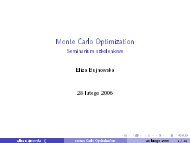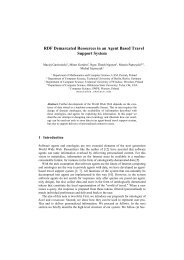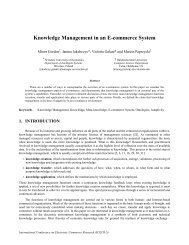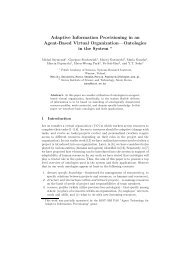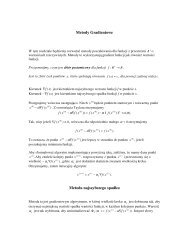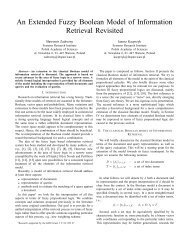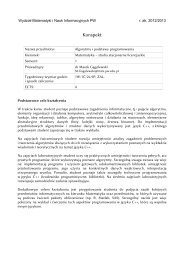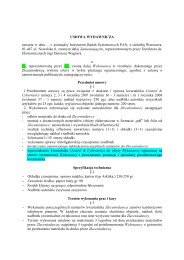Combining Information from Multiple Internet Sources
Combining Information from Multiple Internet Sources
Combining Information from Multiple Internet Sources
You also want an ePaper? Increase the reach of your titles
YUMPU automatically turns print PDFs into web optimized ePapers that Google loves.
3. Algorithms<br />
This part of the thesis provides the detailed description of the three information combination<br />
approaches. This chapter also describes any helper routines that are used by those approaches. Each<br />
of the main algorithms for obtaining the final answer has its pseudo code included as well as the<br />
activity diagrams.<br />
3.1 Game theory method<br />
This sub-chapter presents the Game theory method. This algorithm was used before in the<br />
NeurAge system [9] and had to be adapted to suit the purpose of combination of the data retrieved<br />
<strong>from</strong> the <strong>Internet</strong>. In its original form agents were supposed to vote for certain classes of data; here,<br />
they are voting for certain URLs. The confidence values <strong>from</strong> the original algorithm have been<br />
replaced by the URL ranks according to the algorithm described in section 3.4.1. Also, in its<br />
original form agents were yielding one class as the final answer. In the adapted form agents are<br />
returning 10 URLs in sequence, where any next iteration starts the whole process <strong>from</strong> the<br />
beginning, however without processing the URL which was already selected. This does not violate<br />
the main assumptions of the algorithm and this was stated by Edyta Szymańska of Emory<br />
University, Atlanta by means of personal communication.<br />
In general, a game is defined as follows: it consists of set of players, set of moves<br />
(strategies) and specifications of payoffs for each combination of moves. In case of algorithm which<br />
will be presented in further section game is a normal form game that is defined as follows:<br />
There is a finite set P of players, which we label { ,2,..., m}<br />
1 .<br />
Each player k has finite number of pure strategies (moves)<br />
S k<br />
= { 1, 2, ..., n k<br />
}.<br />
A pure strategy profile is an association of strategies to players,<br />
that is m-tuple<br />
r<br />
σ = ( σ , 1<br />
σ<br />
2<br />
,...,<br />
σ m<br />
)<br />
such that<br />
σ<br />
1<br />
∈ S1, σ<br />
2<br />
∈ S<br />
2<br />
,...,<br />
σ<br />
m<br />
∈ S m<br />
Let strategy profiles be denoted by Σ<br />
A payoff function is a function<br />
F : Σ → R<br />
whose intended representation is the award given to a single player at the outcome of the<br />
game. Accordingly to specify a game the payoff function has to be specified for each player in<br />
P = 1,2,...,<br />
m .<br />
the player set { }<br />
Definition. A game in normal form is a structure<br />
( P , S,<br />
F )<br />
Where P = { 1,2,...,<br />
m}<br />
is a set of players, S ( S , 1<br />
S<br />
2<br />
,...,<br />
S m<br />
)<br />
sets, one for each player and F ( F F ,...,<br />
)<br />
= is a m-tuple of pure strategy<br />
= , 1 2<br />
F m is a m-tuple of payoff functions.<br />
Listing 3.1.1 Definition of the normal form game<br />
21



